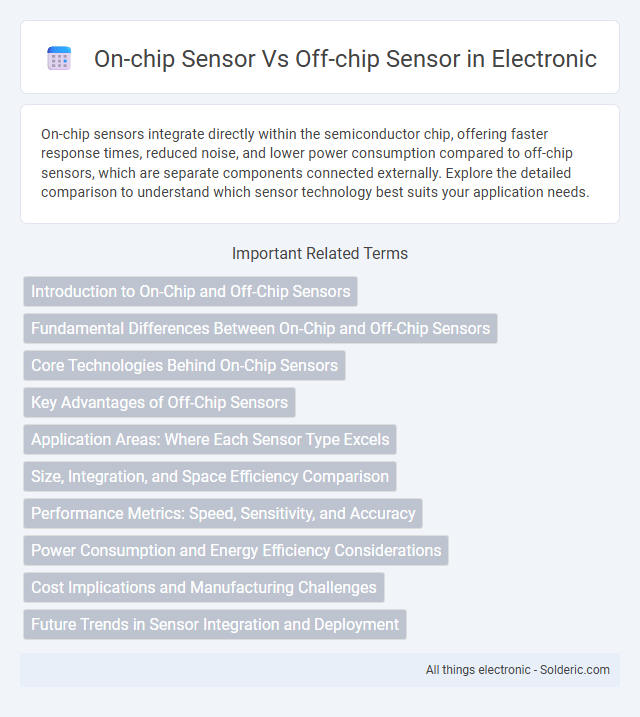On-chip sensors integrate directly within the semiconductor chip, offering faster response times, reduced noise, and lower power consumption compared to off-chip sensors, which are separate components connected externally. Explore the detailed comparison to understand which sensor technology best suits your application needs.
Comparison Table
| Feature | On-Chip Sensor | Off-Chip Sensor |
|---|---|---|
| Integration | Embedded within the IC for compact design | Separate component, connected externally |
| Size | Smaller, space-efficient | Larger, requires additional PCB space |
| Signal Quality | Reduced noise due to short signal path | Higher noise susceptibility over longer connections |
| Cost | Lower in mass production due to integration | Potentially higher due to separate components |
| Flexibility | Limited to IC design constraints | More customizable and replaceable |
| Performance | Optimized for specific IC functions | Can use specialized sensors with higher accuracy |
| Maintenance | Challenging due to embedded nature | Easy to repair or upgrade |
Introduction to On-Chip and Off-Chip Sensors
On-chip sensors are integrated directly within semiconductor chips, enabling real-time data acquisition with minimal signal loss and reduced latency. Off-chip sensors operate externally to the main chip, often providing greater flexibility and specialized sensitivity for environmental or physical measurements. The choice between on-chip and off-chip sensors depends on factors such as measurement accuracy, integration complexity, and application-specific requirements.
Fundamental Differences Between On-Chip and Off-Chip Sensors
On-chip sensors are integrated directly into a semiconductor chip, offering faster response times, reduced noise, and enhanced signal integrity compared to off-chip sensors, which are separate components connected externally. The fundamental difference lies in their proximity to the processing unit, with on-chip sensors enabling compact design and lower latency, while off-chip sensors provide flexibility in sensor selection and easier replacement or upgrades. Your choice between on-chip and off-chip sensors depends on the priority of integration, performance, and system complexity in your application.
Core Technologies Behind On-Chip Sensors
On-chip sensors integrate core technologies such as MEMS (Micro-Electro-Mechanical Systems) and CMOS (Complementary Metal-Oxide-Semiconductor) processes to achieve miniaturized, high-precision sensing directly on semiconductor chips. These technologies enable faster data processing, reduced signal interference, and lower power consumption compared to off-chip sensors, which rely on external components and interconnections. By leveraging advanced photolithography and nanofabrication techniques, on-chip sensors enhance your device's performance through seamless integration and real-time environmental monitoring.
Key Advantages of Off-Chip Sensors
Off-chip sensors offer enhanced flexibility in placement and integration, allowing designers to position them optimally for specific environmental conditions. They provide easier maintenance and replacement compared to on-chip sensors, reducing downtime and overall system costs. You benefit from improved signal quality and reduced interference, as off-chip sensors can be isolated from on-chip electronic noise.
Application Areas: Where Each Sensor Type Excels
On-chip sensors excel in applications requiring high integration and compact design, such as wearables, smartphones, and IoT devices, due to their low power consumption and fast response times. Off-chip sensors are preferred in industrial automation, automotive systems, and environmental monitoring where higher accuracy, robustness, and broader sensing ranges are critical. The choice hinges on balancing sensor precision, integration level, and environmental resilience for specific application demands.
Size, Integration, and Space Efficiency Comparison
On-chip sensors are significantly smaller than off-chip sensors due to their direct integration onto the semiconductor die, enabling compact device designs and reduced signal path lengths. Integration of on-chip sensors simplifies manufacturing processes by embedding sensing elements within the chip architecture, enhancing system reliability and minimizing parasitic effects. Compared to off-chip sensors, on-chip solutions offer superior space efficiency, allowing for denser electronic assemblies and improved overall device miniaturization in applications such as IoT and wearable technology.
Performance Metrics: Speed, Sensitivity, and Accuracy
On-chip sensors offer faster data processing speeds and lower latency compared to off-chip sensors due to their proximity to the processing unit, enhancing real-time responsiveness. Sensitivity in on-chip sensors is often optimized for specific applications with integrated calibration, while off-chip sensors may provide broader dynamic ranges suitable for varied environments. Accuracy benefits from reduced signal degradation and noise in on-chip sensors, but off-chip sensors can achieve high precision through advanced external components, impacting your choice based on performance needs.
Power Consumption and Energy Efficiency Considerations
On-chip sensors typically offer lower power consumption and higher energy efficiency due to their integration with the chip's circuitry, reducing signal loss and minimizing external communication needs. Off-chip sensors, while often more flexible in placement and variety, generally consume more power because of longer signal transmission paths and additional interfacing components. Optimizing energy efficiency in sensor systems relies heavily on the proximity of sensing elements to processing units, making on-chip sensors the preferred choice for low-power, high-performance applications.
Cost Implications and Manufacturing Challenges
On-chip sensors typically offer lower overall system costs by integrating sensing elements directly onto the semiconductor die, reducing packaging and assembly expenses compared to off-chip sensors, which require separate components and additional interfaces. Manufacturing challenges for on-chip sensors include complex process integration and strict compatibility requirements with standard CMOS technology, often leading to higher initial development costs. Off-chip sensors face challenges related to precise alignment, packaging durability, and increased material costs, impacting manufacturing scalability and long-term reliability.
Future Trends in Sensor Integration and Deployment
On-chip sensors are advancing with trends in miniaturization and integration within semiconductor devices, enabling real-time data processing and reduced latency in applications such as IoT and autonomous systems. Off-chip sensors continue to evolve by leveraging wireless connectivity and modular designs, facilitating flexible deployment and easier maintenance in industrial and environmental monitoring. Future sensor ecosystems will likely blend on-chip and off-chip solutions, optimizing performance, scalability, and energy efficiency across diverse sectors.
On-chip sensor vs off-chip sensor Infographic

 solderic.com
solderic.com